Inlecypris auropurpurea
SynonymsTop ↑
Barilius auropurpureus Annandale, 1918; Devario auropurpureus (Annandale 1918); Inlecypris auropurpureus (Annandale, 1918)
Etymology
Inlecypris: from Inlé, referring to Inlé Lake, Myanmar, to which the type species is endemic, and Cypris, a common suffix for cyprinid genera.
auropurpureus: from the Latin aurum, meaning ‘gold’, and purpureus, meaning ‘clothed in purple’.
Classification
Order: Cypriniformes Family: Cyprinidae
Distribution
Known only from the isolated lake of Inlé and surrounding watershed in Shan state, eastern Myanmar.
Type locality is given as ‘Inlé Lake basin, South Shan States, Myanmar’.
The species is currently listed as ‘Endangered’ on the IUCN Red List due to a significant decline in the wild population. Unsustainable agricultural practices in and around the lake have caused increases in sedimentation, eutrophication, and pollution along with a reduction in surface area of more than 30% between the years 1935-2000. Non-native, predatory Parambassis and Tilapia species have been introduced for farming, while collection for the aquarium trade may also be exerting a negative effect.
Habitat
Lake Inlé lies in a karstic valley almost 900m above sea level in the Shan Plateau region and is home to many endemic animals including nine species of fish and numerous gastropods. The water is clear, shallow (2-3 metres deep in most places) and has a very fertile, loamy substrate, although it can be muddy and turbid around the margins.
It is famed for its stilted villages and local fishermen known as Intha who row their boats using only one leg. These people, thought to have migrated from the south of Myanmar in the late 1300s, use naturally-occurring floating ‘islands’ consisting of tangles of various plant species as gardens.
These islands form a wide raft around the lake margins, rising and falling with the water level, and have come to form the habitats of many fishes which take shelter among the tangle of roots and plant stems at their base. Macrophytes also grow densely in places.
Maximum Standard Length
60 – 80 mm.
Aquarium SizeTop ↑
An aquarium with a base measuring 90 ∗ 30 cm or equivalent should be the minimum considered.
Maintenance
Best maintained in a densely-planted tank and an excellent choice for the carefully-aquascaped set-up. The addition of some floating plants to diffuse the light entering also seems to be appreciated.
Water movement does not need to be particularly strong, and the tank must have a tightly-fitting cover as it is a particularly accomplished jumper.
Water Conditions
Temperature: 20 – 24 °C
pH: 6.0 – 8.0
Hardness: 54 – 268 ppm
Diet
Preys chiefly on insects and aquatic invertebrates in nature. Annandale (1918) observed it feeding on trichopterids (caddis flies) and ephemeropterids (may flies) from the surface in the evenings, whereas during daylight hours insect larvae and worms were taken from the substrate.
In the aquarium it is a largely unfussy feeder and will accept most foods. A good quality dried product can be used as the staple diet, but this should be supplemented with regular meals of small live and frozen fare such as chironomid larvae (bloodworm), Daphnia, Artemia, etc.
Behaviour and CompatibilityTop ↑
This species is peaceful but will not compete well with larger or more boisterous tankmates.
It can be skittish, but this behaviour can be minimised by the addition of floating plants or maintaining it alongside other pelagic species.
It is a schooling species so ideally a group of at least 8-10 specimens should be purchased.
Sexual Dimorphism
Sexually mature females are more robust, less colourful, and a little larger than males.
Reproduction
Like many small cyprinids this species scatters eggs randomly, typically among aquatic vegetation, and does not exhibit parental care. If the fish are in good condition they will spawn often and in a mature planted aquarium it is possible that small numbers of fry may start to appear without intervention.
However if you want to increase the yield a slightly more controlled approach is required. The adult group can still be conditioned together but one or more smaller containers should also be set up and filled with aged water. Fill much of the available space with fine wool mops, Taxiphyllum or other fine-leaved plant, or cover the base with some kind of mesh of a large enough grade so that the eggs can fall through but small enough so that the adults cannot reach them. The widely available plastic ‘grass’-type matting can also be used and works well, as does a layer of glass marbles.
The water itself should be of slightly acidic to neutral pH with a temperature towards the upper end of the range suggested above, and an air-powered sponge filter or air stone(s) should also be included to provide oxygenation and water movement.
When the adults are well-conditioned and the females appear gravid one or two pairs should then be introduced. Spawning should occur within 24 hours with the fish left in place for a maximum of 48 hours.
Incubation is temperature-dependant to an extent but typically lasts 50-60 hours with the young free-swimming a few days later. Initial food should be Paramecium or similar, introducing Artemia nauplii, microworm, powdered dry foods, etc., once the fry are large enough to accept them.
NotesTop ↑
Originally described as a member of Barilius (Annandale, 1918) but Howes (1980a) considered it more closely related to cheline cyprinids (Chela and Laubuca spp.) based on morphological characters and erected the genus Inlecypris for it (Howes, 1980b).
Fang (2003) supported Howes’ conclusions in her 2003 phylogenetic study of the genus Danio, hypothesising that Inlecypris and Chela together form a sister group to Devario. In a more recent phylogenetic work (Fang et al., 2009) I. auropurpurea was found to be most closely-related to the similarly-patterned Devario maetaengensis and D. shanensis, thus rendering Devario paraphyletic.
Inlecypris was therefore synonymised with Devario, a decision ratified by Tang et al. (2010), but this was reversed by Kottelat (2013) on the basis that Inlecypris species are very distinct in terms of appearance. In doing so, he noted that phylogenetic evidence suggest the existence of two genetic lineages within Devario. The first contains the species with prominent lateral stripes, which leaves the remaining members of uncertain taxonomic placement. Two of the latter grouping are currently referred to as ‘Inlecypris‘ maetaengensis and ‘I.‘ shanensis, respectively, in order to retain monophyly of Inlecypris, but will probably be moved into a separate genus at a later date, where they may be joined by Devario apogon and D. chrysotaeniatus.
References
- Annandale, N., 1918 - Records of the Indian Museum (Calcutta) 14: 33-64
Fish and fisheries of the Inlé Lake. - Fang, F., 2003 - Copeia 2003(4): 714-728
Phylogenetic Analysis of the Asian Cyprinid Genus Danio (Teleostei, Cyprinidae). - Fang, F., M. Norén, T. Y. Liao, M. Källersjö and S. O. Kullander, 2009 - Zoologica Scripta 38(1): 1-20
Molecular phylogenetic interrelationships of the south Asian cyprinid genera Danio, Devario and Microrasbora (Teleostei, Cyprinidae, Danioninae). - Howes, G. J., 1980a - Bulletin of the British Museum (Natural History) Zoology series 37: 129-198
The anatomy, phylogeny and classification of bariliine cyprinid 2006 fishes. - Howes, G. J., 1980b - Bulletin of the British Museum (Natural History) Zoology series 38: 171-173
A new genus of cheline cyprinid fishes. - Kottelat, M., 2013 - Raffles Bulletin of Zoology Supplement 27: 1-663
The fishes of the inland waters of southeast Asia: a catalogue and core bibiography of the fishes known to occur in freshwaters, mangroves and estuaries. - Mayden, R. L., K. L. Tang, K. W. Conway, J. Freyhof, S. Chamberlain, M. Haskins, L. Schneider, M. Sudkamp, R. M. Wood, M. Agnew, A. Bufalino, Z. Sulaiman, M. Miya, K. Saitoh, S. He, 2007 - Journal of Experimental Zoology, Molecular Development and Evolution 308B: 642-654
Phylogenetic relationships of Danio within the order Cypriniformes: a framework for comparative and evolutionary studies of a model species. - Pramod, P. K. , F. Fang, K. Rema Devi, T.-Y. Liao, T. J. Indra, K. S. Jameela Beevi and S. O. Kullander, 2010 - Zootaxa 2519: 31-47
Betadevario ramachandrani a new danionine genus and species from the Western Ghats of India (Teleostei: Cyprinidae: Danioninae). - Sanger, T. J. and A. R. McCune, 2002 - Zoological Journal of the Linnean Society 135: 529-546
Comparative osteology of the Danio (Cyprinidae: Ostariophysi) axial skeleton with comments on Danio relationships based on molecules and morphology. - Tang, K. L., M. K. Agnew, W. J. Chen., M. V. Hirt, T. Sado, L. M. Schneider, J. Freyhof, Z. Sulaiman, E. Swartz, C. Vidthayanon, M. Miya, K. Saitoh, A. M. Simons, R. M. Wood and R. L. Mayden, 2010 - Molecular Phylogenetics and Evolution 57(1): 189-214
Systematics of the subfamily Danioninae (Teleostei: Cypriniformes: Cyprinidae).
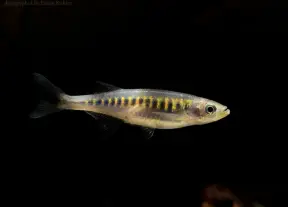
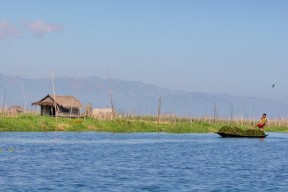

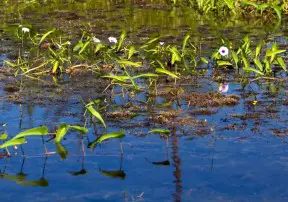
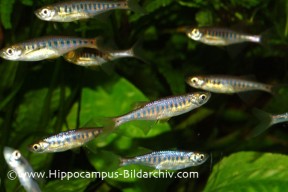

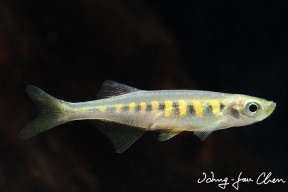

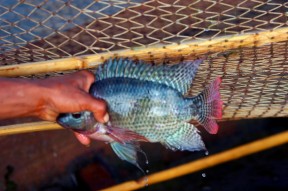
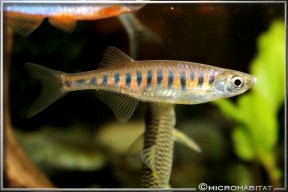
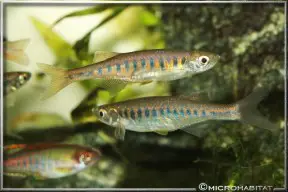
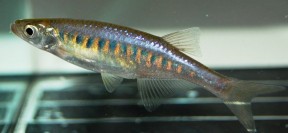

October 8th, 2014 at 11:06 am
I have maintained a small school (5) of these fish for the past three years. At the time I bought all that were available. Only now are fish from the school starting to die off; I would guess from old age. Unlike what the article says, even my smallest fish is bigger than 80mm/3″. My biggest is almost as long as my full grown boesemani rainbows.
Mine have never been particularly nervous and only slightly skittish. What I mean by that, is they are sensitive to motion outside the tank, but they’ll only dart a few inches and then calm down immediately. I did have one jump out of the tank on me, but it was while someone was tank-sitting for me, so I’m not entirely sure of the circumstances. I’ve never personally seen them try to jump.
They are the most tolerant danio I’ve ever kept (and I’ve kept 13 distinct species). They were housed completely safely with celestial pearl danio, emerald dwarf rasbora, and gold ring danio, which are all under an 1″ long. They would even let the other small fish school with them. That being said, they primarily seem to be interested in their own species. I was given another single danio from Lake Inle (Devario Jayarami) who slipped in with the batch and they seemed more interested in her than most other species.
I have had them spawn a few times for me, but have never had the resources to save the eggs and raise the fry. My males do have a deeper color than my females. They also seem to have deeper dorsal and anal fins.
If I could ever find this species again, I’d buy them in a heartbeat. They’re beautiful, incredibly peaceful, and make the best dither fish I’ve ever seen.
August 2nd, 2015 at 6:50 pm
Hi, are your fish 80 mm+ SL or TL? Regarding the jumping, I’ve kept this species myself and the fish did jump in the first few weeks but settled down after. I’ve modified the text a little to reflect your comments.